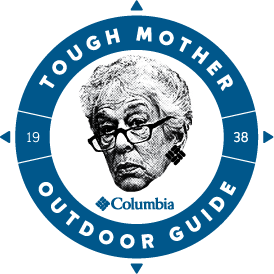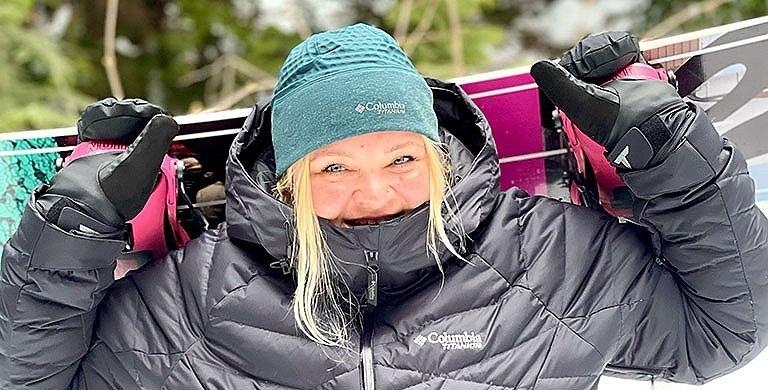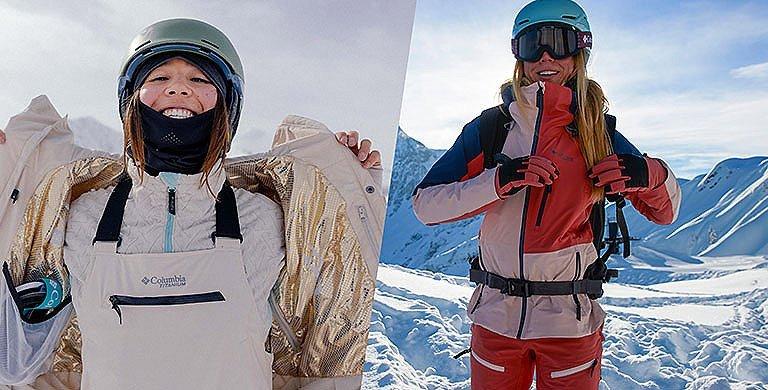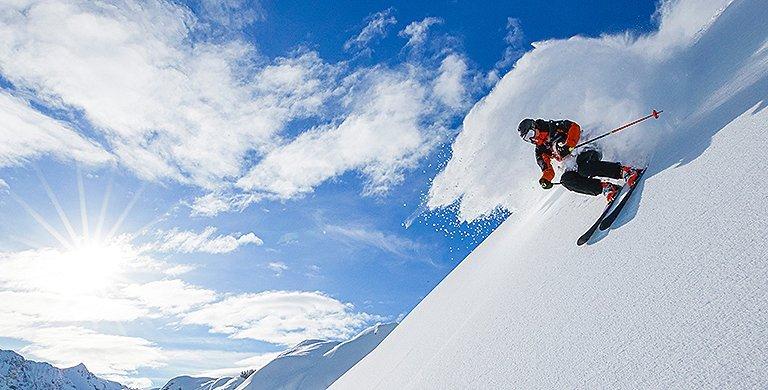SKI & SNOW
Tips for Skiing With Kids
From renting gear to staying warm, these tips will help you and your kids enjoy your day on the mountain
BY RACHEL CAVANAUGH
You have a vision of how it’s going to be the first time you take your kids skiing or snowboarding: tandem skiing down the mountain in perfect harmony as you sip hot cocoa out of a thermos, bluebirds flying overhead.
It’s a beautiful image—but the reality may look a bit different once you get out there. Instead of perfect tandem turns, you might find yourself spending most of the day scooping your kids up off the icy ground as you wipe their noses or beg them to put their gloves back on.
But there’s a happy medium that exists between these two extremes. To help you find it, we enlisted the help of Suzi Coleman Wilhelmsen, a former Vail Mountain Resort instructor and K-12 teacher, who also taught her own three children to ski. Wilhelmsen shared her favorite tips for a successful day of skiing with children.
It’s a beautiful image—but the reality may look a bit different once you get out there. Instead of perfect tandem turns, you might find yourself spending most of the day scooping your kids up off the icy ground as you wipe their noses or beg them to put their gloves back on.
But there’s a happy medium that exists between these two extremes. To help you find it, we enlisted the help of Suzi Coleman Wilhelmsen, a former Vail Mountain Resort instructor and K-12 teacher, who also taught her own three children to ski. Wilhelmsen shared her favorite tips for a successful day of skiing with children.
1. Do an honest self-assessment
Before hitting the mountain with your kids for the first time, you need to decide whether you’re going to teach them to ski yourself or put them in a lesson. In order to do this, Wilhelmsen advocates for an honest self-assessment.
“Determine your level of capability,” she says. “Are you a solid intermediate skier or higher? If so, you’re fine to teach them on your own. But if not, you should opt for a lesson.”
Don’t just think about your physical skills when making an assessment, she adds. Consider the other qualities you’ll need to be a good ski instructor for your kids.
“You have to be honest with yourself,” she says. “Do I have the stamina? Do I have the patience? Can I stay positive and separate from myself as a mom or a dad? If my kids aren't following my directions, am I going to be able to keep my cool?
“Because you don't want your kids to have a negative experience. You want to make sure this whole thing is as positive as possible because learning to ski is hard enough as it is. Between all the equipment, the drive, the planning, the expense, it can be overwhelming. So make that determination first, and then choose your course.”
“Determine your level of capability,” she says. “Are you a solid intermediate skier or higher? If so, you’re fine to teach them on your own. But if not, you should opt for a lesson.”
Don’t just think about your physical skills when making an assessment, she adds. Consider the other qualities you’ll need to be a good ski instructor for your kids.
“You have to be honest with yourself,” she says. “Do I have the stamina? Do I have the patience? Can I stay positive and separate from myself as a mom or a dad? If my kids aren't following my directions, am I going to be able to keep my cool?
“Because you don't want your kids to have a negative experience. You want to make sure this whole thing is as positive as possible because learning to ski is hard enough as it is. Between all the equipment, the drive, the planning, the expense, it can be overwhelming. So make that determination first, and then choose your course.”
2. Rent, don’t buy
Although Wilhelmsen says it can be tempting to buy an old pair of skis and bindings off Craigslist or Facebook Marketplace, she recommends renting equipment first.
“You want to rely on someone who is a true expert to pick out their gear,” she says. “Go to your local ski shop where you've got ski professionals who can find them exactly what they need.” In addition to ensuring they get the right equipment and that everything fits them properly, this will be more cost-effective too.
“Your kids are growing,” she explains. “They're going to be growing for a while, and they're going to grow out of that stuff. So don't make a huge investment. Unless you live on the mountain or very close to the ski resort where you're going to be out there every day, it won’t be worth it.”
Renting skis or snowboards is fairly inexpensive these days, she says. Most gear shops have seasonal packages that allow you to rent equipment for the whole year. You’ll get newer, higher-quality gear and you won’t have to rummage through all the old, worn-down equipment online or in secondhand shops.
“I used to see it all the time as an instructor,” Wilhelmsen recalls. “Kids would show up with outdated equipment or boots that were too big, boots that didn't fit the bindings, all sorts of issues. Then they'd lose half a day of skiing because their parents had to go back inside and get better gear from them.”
Instead, find a reputable ski shop and rent equipment for the whole year, if possible. If that’s not an option, day or weekend rentals work fine too. Whatever you do, just make sure to plan ahead, she says. Seasonal rentals often sell out, so reserve them early, before the ski season starts. If you opt for daily rentals, make a reservation online or get to the mountain early because those sell out too.
“You want to rely on someone who is a true expert to pick out their gear,” she says. “Go to your local ski shop where you've got ski professionals who can find them exactly what they need.” In addition to ensuring they get the right equipment and that everything fits them properly, this will be more cost-effective too.
“Your kids are growing,” she explains. “They're going to be growing for a while, and they're going to grow out of that stuff. So don't make a huge investment. Unless you live on the mountain or very close to the ski resort where you're going to be out there every day, it won’t be worth it.”
Renting skis or snowboards is fairly inexpensive these days, she says. Most gear shops have seasonal packages that allow you to rent equipment for the whole year. You’ll get newer, higher-quality gear and you won’t have to rummage through all the old, worn-down equipment online or in secondhand shops.
“I used to see it all the time as an instructor,” Wilhelmsen recalls. “Kids would show up with outdated equipment or boots that were too big, boots that didn't fit the bindings, all sorts of issues. Then they'd lose half a day of skiing because their parents had to go back inside and get better gear from them.”
Instead, find a reputable ski shop and rent equipment for the whole year, if possible. If that’s not an option, day or weekend rentals work fine too. Whatever you do, just make sure to plan ahead, she says. Seasonal rentals often sell out, so reserve them early, before the ski season starts. If you opt for daily rentals, make a reservation online or get to the mountain early because those sell out too.
3. Keep them warm
It may seem like a no-brainer, but Wilhelmsen says you'd be amazed how many parents show up at lessons with kids who are ill-equipped for the day. Some are wearing clothes that don’t fit them properly and are constantly slipping down or riding up. Others simply don’t know what gear their kids need, or how to dress them for cold weather.
“If your kid is cold, your kid is uncomfortable. And if they’re uncomfortable, they won't want to ski—that's the formula.”
When it comes to ski clothing, it’s worth it to invest in higher-quality performance gear, she says. If possible, skip the hand-me-downs and opt for ski-specific gear that is waterproof, breathable, and quick drying. Wilhelmsen points to three pieces of gear that are especially critical.
“For winter skiing, three of the most important things your kid needs is a balaclava, a good pair of mittens, and a properly fitted helmet.” She likes balaclavas because they cover the whole face and can’t slide down like regular neck gaiters can. Plus, they prevent cold jacket zippers from rubbing against their chins and causing irritation.
Cold hands are often the first thing kids complain about, so Wilhelmsen likes mittens for the superior warmth they provide compared to standard gloves. “Get gloves for yourself, fine,” she says, “but your kids need mittens.
It goes without saying that the safety and wellbeing of your children is your number one priority. A properly fitted helmet is an integral part of any child's ski or snowboard gear.
“And another little ‘mom’ tip? Mittens also allow you to keep a little wad of tissues in your hand at all times as a bonus.”
“If your kid is cold, your kid is uncomfortable. And if they’re uncomfortable, they won't want to ski—that's the formula.”
When it comes to ski clothing, it’s worth it to invest in higher-quality performance gear, she says. If possible, skip the hand-me-downs and opt for ski-specific gear that is waterproof, breathable, and quick drying. Wilhelmsen points to three pieces of gear that are especially critical.
“For winter skiing, three of the most important things your kid needs is a balaclava, a good pair of mittens, and a properly fitted helmet.” She likes balaclavas because they cover the whole face and can’t slide down like regular neck gaiters can. Plus, they prevent cold jacket zippers from rubbing against their chins and causing irritation.
Cold hands are often the first thing kids complain about, so Wilhelmsen likes mittens for the superior warmth they provide compared to standard gloves. “Get gloves for yourself, fine,” she says, “but your kids need mittens.
It goes without saying that the safety and wellbeing of your children is your number one priority. A properly fitted helmet is an integral part of any child's ski or snowboard gear.
“And another little ‘mom’ tip? Mittens also allow you to keep a little wad of tissues in your hand at all times as a bonus.”
4. Dress them in layers
Winter accessories like balaclavas and mittens are important, but don’t forget the rest of their gear. Items like ski jackets and snow pants are critical pieces of the “stay warm” puzzle too, and dressing in layers is the best way to put it all together. That way, if they get too warm, they can take a layer off, and vice versa.
“You want to have a three-layer system,” Wilhelmsen explains. “One thin layer against their skin that wicks moisture—a simple baselayer. Then a nice warm midlayer such as a fleece or puffer jacket. Avoid the cotton hoodie or anything cotton. You want breathable, moisture-wicking materials. They can even wear a windbreaker.
“A vest is another great option that will protect their inner core but not be as bulky around the arms. Then their ski jacket on the outside, and of course their pants are important too. Regardless of season, make sure they're fully waterproof.”
Any beginner skier or snowboarder, no matter their age, is going to spend a lot of time on the ground in the snow, she notes. As they sit on the ground, their body warms up the snow and it’s going to melt. “If you're wet, you're cold. That’s true in the middle of winter when it’s super cold, and as the season progresses, spring is going to be slushy. So you've always got wet snow. That’s why you always need fully waterproof gear that will keep them dry.
“And a lot of ski jackets today come in interchange styles where the layers zip in and out. Those are really helpful too.”
Wilhelmsen says that when her kids were little she used to always carry a backpack to store layers, but notes that it requires being a confident skier. “If you’re proficient enough to wear a backpack, I would recommend that. Just keep in mind that they can be difficult for beginners, so only do that if you are a strong enough skier to manage it. But it helps a lot with the layering.”
“You want to have a three-layer system,” Wilhelmsen explains. “One thin layer against their skin that wicks moisture—a simple baselayer. Then a nice warm midlayer such as a fleece or puffer jacket. Avoid the cotton hoodie or anything cotton. You want breathable, moisture-wicking materials. They can even wear a windbreaker.
“A vest is another great option that will protect their inner core but not be as bulky around the arms. Then their ski jacket on the outside, and of course their pants are important too. Regardless of season, make sure they're fully waterproof.”
Any beginner skier or snowboarder, no matter their age, is going to spend a lot of time on the ground in the snow, she notes. As they sit on the ground, their body warms up the snow and it’s going to melt. “If you're wet, you're cold. That’s true in the middle of winter when it’s super cold, and as the season progresses, spring is going to be slushy. So you've always got wet snow. That’s why you always need fully waterproof gear that will keep them dry.
“And a lot of ski jackets today come in interchange styles where the layers zip in and out. Those are really helpful too.”
Wilhelmsen says that when her kids were little she used to always carry a backpack to store layers, but notes that it requires being a confident skier. “If you’re proficient enough to wear a backpack, I would recommend that. Just keep in mind that they can be difficult for beginners, so only do that if you are a strong enough skier to manage it. But it helps a lot with the layering.”
5. Skip the hand warmers
When you have shivering children complaining that their hands and feet are cold, it makes sense to consider using disposable hand warmers. After all, they definitely warm things up quickly. However, Wilhelmsen urges against them, noting they can backfire.
“You put them in their mittens or boots, and they’re great at first—their hands or feet warm right up. But then they start to get clammy because you've got this packet of hot chemicals against their skin. This is fine while they are still going, but then they wear off. They don't last all day. Now their hands are clammy and it’s cold. Wet equals cold. Wet will freeze.
“Your kids are going to end up colder in the end than if they’d just let their own body temperature and movement keep them warm. So my advice is to skip the hand warmers.”
“You put them in their mittens or boots, and they’re great at first—their hands or feet warm right up. But then they start to get clammy because you've got this packet of hot chemicals against their skin. This is fine while they are still going, but then they wear off. They don't last all day. Now their hands are clammy and it’s cold. Wet equals cold. Wet will freeze.
“Your kids are going to end up colder in the end than if they’d just let their own body temperature and movement keep them warm. So my advice is to skip the hand warmers.”
6. Do a trial run at home
Instead of waiting until you’re out on the mountain in freezing cold temperatures, battling nasty weather, and bundled up in a million layers, walk your kids through their gear in the comfort of your living room. Before you hit the ski report, have them try on their boots and walk around the house. Show them how the bindings come on and off.
“Introduce your kid to the equipment,” Wilhelmsen says. “Have them put everything on at your house before you get up on the hill. Your kid should know what all of this stuff is, how to put it on, how to take it off. Show them how to snap their boots into the bindings, or if they’re on a snowboard, how to ratchet them down.
“Make sure everything fits, make sure it's comfortable, and that they don't have socks bunching up in their boots. If they’re in ski boots, do the heel-toe walk so they can get used to it because it's going to feel like they're walking on the moon the first time. They should go through the whole process inside before they ever go outside in the cold.”
If you’ve opted for a daily rental and don’t have your equipment at home ahead of time, you can still have a rental technician at the gear shop go through everything with them, and then practice walking around inside the lodge. The main thing is to make sure they’re not testing their gear for the first time out in the elements.
“Introduce your kid to the equipment,” Wilhelmsen says. “Have them put everything on at your house before you get up on the hill. Your kid should know what all of this stuff is, how to put it on, how to take it off. Show them how to snap their boots into the bindings, or if they’re on a snowboard, how to ratchet them down.
“Make sure everything fits, make sure it's comfortable, and that they don't have socks bunching up in their boots. If they’re in ski boots, do the heel-toe walk so they can get used to it because it's going to feel like they're walking on the moon the first time. They should go through the whole process inside before they ever go outside in the cold.”
If you’ve opted for a daily rental and don’t have your equipment at home ahead of time, you can still have a rental technician at the gear shop go through everything with them, and then practice walking around inside the lodge. The main thing is to make sure they’re not testing their gear for the first time out in the elements.
7. Take lots of breaks
Don’t wait to take a break until your kids are crying and exhausted and begging you to take them inside. Be on the lookout for signs they’re getting cold or tired, and rest when you need to throughout the day. Each kid will have a different tolerance level when it comes to the cold, or how long they want to ski.
“Your kids are going to give you indicators when they're getting tired or cold. They're going to start slowing down. They'll start having a harder time getting up. They’ll start making mistakes they didn't make earlier in the day.
“You need to be aware and ask them how they’re doing. Say, ‘Hey, you're looking great—how are you feeling?’ Look for fatigue. You know your kid best. The whole point is to keep it fun.”
“Your kids are going to give you indicators when they're getting tired or cold. They're going to start slowing down. They'll start having a harder time getting up. They’ll start making mistakes they didn't make earlier in the day.
“You need to be aware and ask them how they’re doing. Say, ‘Hey, you're looking great—how are you feeling?’ Look for fatigue. You know your kid best. The whole point is to keep it fun.”
8. Mentally prepare yourself
One last tip to better enjoy skiing with kids, especially for the first time, is to be realistic about your expectations. Namely, accept from the start that you’re probably not going to do much skiing on your own.
“Don’t be expecting that dream where you and your four-year-old are tandem skiing in slow motion down the hill,” Wilhelmsen says. “It’s not going to be like that. It’s going to be a lot of you picking your kid up, holding your kid's hand, holding them with one arm, and helping them get back up. A lot of repeating the same thing over and over again.
“And all of that is going to require a lot of patience. That’s what this stage is all about. But if you stick with it and stay positive, it’s going to pay off and you’re going to give them an amazing gift that will last a lifetime.”
“Don’t be expecting that dream where you and your four-year-old are tandem skiing in slow motion down the hill,” Wilhelmsen says. “It’s not going to be like that. It’s going to be a lot of you picking your kid up, holding your kid's hand, holding them with one arm, and helping them get back up. A lot of repeating the same thing over and over again.
“And all of that is going to require a lot of patience. That’s what this stage is all about. But if you stick with it and stay positive, it’s going to pay off and you’re going to give them an amazing gift that will last a lifetime.”
Ready to gear up for the slopes? Check out Columbia Sportswear’s collection of ski clothes.



